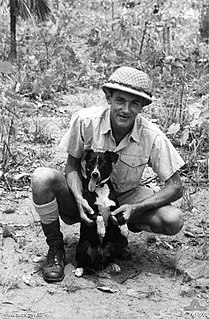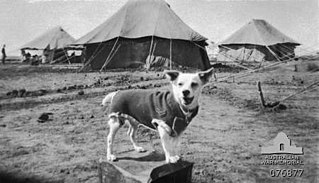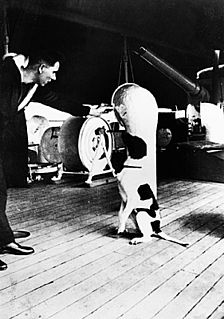 W
WBamse was a St. Bernard dog that became the heroic mascot of the Free Norwegian Forces during the Second World War. He became a symbol of Norwegian freedom during the war.
 W
WBing was a dog who received the Dickin Medal in 1947 from the People's Dispensary for Sick Animals for bravery in service during the Second World War.
 W
WGunner was a male kelpie dog who became notable for his reliability to accurately alert Allied air force personnel that Japanese military aircraft were approaching Darwin during the Second World War.
 W
WHorrie the Wog Dog was the unofficial mascot for the 2/1st Machine Gun Battalion of the Second Australian Imperial Force. An Egyptian terrier, the dog was befriended by a soldier serving in the unit when it was stationed in Egypt during the Second World War. The dog subsequently followed the battalion throughout various locations in the Middle East and in Greece and Crete, before being smuggled back to Australia in 1942. In 1945, the dog became the subject of a book by author Ion Idriess, and is believed to have been destroyed by quarantine officials, although this remains the subject of speculation with some researchers claiming that the dog survived after its owner switched it with another prior to destruction.
 W
WHorses in World War II were used by the belligerent nations for transportation of troops, artillery, materiel, and, to a lesser extent, in mobile cavalry troops. The role of horses for each nation depended on its military strategy and state of economy and was most pronounced in the German and Soviet Armies. Over the course of the war, both Germany and the Soviet Union employed more than six million horses.
 W
WJudy was a ship's dog on board HMS Gnat and HMS Grasshopper stationed on the Yangtze before and during World War II. She proved able to hear incoming aircraft, providing the crew with an early warning. After part of the crew transferred from the Gnat to the Grasshopper in June 1939 the ship was sent to Singapore after the British declaration of war on Germany. There she was on board the ship during the Battle of Singapore, which saw Grasshopper evacuate for the Dutch East Indies. It was sunk en route, and Judy was nearly killed having been trapped by a falling row of lockers. She was rescued when a crewman returned to the stricken vessel looking for supplies.
 W
WJust Nuisance was the only dog ever to be officially enlisted in the Royal Navy. He was a Great Dane who between 1939 and 1944 served at HMS Afrikander, a Royal Navy shore establishment in Simon's Town, South Africa. He died in 1944 at the age of seven years and was buried with full military honours.
 W
WThe Königsberger Paukenhund was the traditional kettle drum dog of the Prussian infantry based in the East Prussian capital of Königsberg.
 W
WLin Wang was an Indian elephant that served with the Chinese Expeditionary Force during the Second Sino-Japanese War (1937–1945) and later relocated to Taiwan with the Kuomintang forces. Lin Wang lived out most of his life in the Taipei Zoo and unquestionably was the most popular and famous animal in Taiwan. Many adults and children alike affectionately called the bull elephant "Grandpa Lin Wang."
 W
WKing Neptune was a pig used by a United States Navy recruiter to raise $19 million in war bonds for the construction of the Iowa-class battleship Illinois between 1942 and 1946.
 W
WNigger was a male black labrador retriever belonging to Wing Commander Guy Gibson of the Royal Air Force, and the mascot of No. 617 Squadron. Gibson owned the dog when he was previously a member of 106 Squadron. Nigger often accompanied Gibson on training flights and was a great favourite of the members of both 106 and 617 Squadrons. He was noted for his liking of beer, which he drank from his own bowl in the Officers' Mess.
 W
WRob was a Collie dog who in February 1945 was awarded the Dickin Medal, considered to be the animals' Victoria Cross. He was alleged to have made over 20 parachute descents during the North African Campaign, serving with the SAS. However, in 2006, his actions were revealed as being a possible hoax perpetrated by members of his regiment in order to prevent Rob leaving after his original owners requested his return.
 W
WSinbad was a mixed-breed dog that was one of two animals to be classified as non-commissioned officers by an arm of the United States military, rather than property, prior to the enactment of regulations to prohibit such after being enlisted by the creative crew of USCGC Campbell. Prior to and after an official retirement, Sinbad was assigned the title of Chief Dog, his rank being that of Chief Petty Officer. At the time of the biography written by George Foley, no other member of the United States Coast Guard had yet been the subject of a published biography. Sinbad spent 11 years at sea on the Campbell including combat in World War II that became widely publicized as part of the homefront campaign.
 W
WSmoky, a Yorkshire Terrier, was a famous war dog who served in World War II. She weighed only 4 pounds (1.8 kg) and stood 7 inches (180 mm) tall. Smoky is credited with beginning a renewal of interest in the once-obscure Yorkshire Terrier breed.
 W
WWojtek was a Syrian brown bear bought, as a young cub, at a railway station in Hamadan, Iran, by Polish II Corps soldiers who had been evacuated from the Soviet Union. In order to provide for his rations and transportation, he was eventually enlisted officially as a soldier with the rank of private, and was subsequently promoted to corporal.